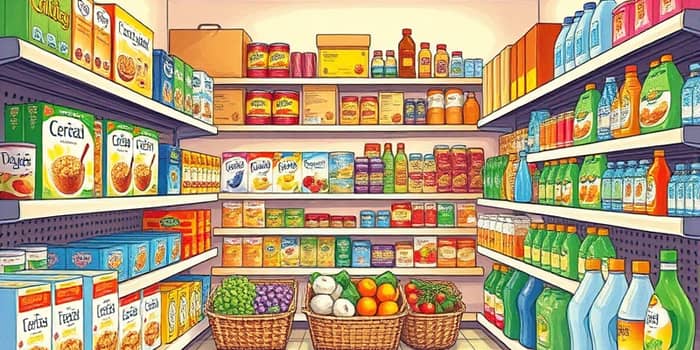
In an era defined by economic uncertainty, consumer staples have emerged as a beacon of reliability. As households adjust spending, the essentials sector continues to demonstrate remarkable resilience. Investors and consumers alike can draw valuable lessons from how these companies navigate inflationary pressures and supply chain disruptions.
Below, we explore the factors underpinning sector stability in 2025, the headwinds companies face, and the strategic moves that preserve margins and market share.
Headline inflation in the U.S. rose to 2.4% year-over-year by May 2025, with food prices climbing 2.9% over the prior year. Within the grocery aisle, price movements have been uneven: eggs soared 41.5%, coffee increased 11.5%, and beef and veal rose 8.6%. Meanwhile, restaurant prices jumped 3.8%.
Although overall inflation appears to be moderating compared to the peaks of 2022, food prices remain 31% higher than 2019 levels. Consumers are acutely aware of this backdrop, scrutinizing every receipt and often seeking value alternatives when staples stretch household budgets further.
Tariff regimes continue to exert pressure on certain categories. Fresh produce prices climbed 4.3% in early 2025, while textiles faced a 16% spike before retailers rapidly sourced alternatives. Packaging inputs such as aluminum and steel—subject to duties—have led to broad-based cost increases in canned and bottled goods.
Fortunately, most consumer staples companies have pursued domestic production and reshoring efforts, limiting direct exposure to tariffs. However, items like imported spirits and products with overseas components remain vulnerable to further price hikes if trade tensions intensify.
Consumer staples are widely regarded as a defensive choice for portfolios. Demand for essentials—food, personal care, household goods—is relatively inelastic. During periods of economic slowdown or market underperformance, staples often outshine cyclical sectors.
Historical data confirms this resilience. In 2024, the sector delivered positive returns even as broader markets wavered. Looking ahead, potential Federal Reserve rate cuts may bolster overall sentiment, but if economic growth disappoints, staples could once again demonstrate relative outperformance.
Leading firms are leveraging strong brands to defend margins. Procter & Gamble implemented a 3.2% price increase on laundry products in Q1 2025, yet sustained sales volumes. Church & Dwight reshored key ingredient sourcing in 2024, boosting margins by 14%. Coca-Cola’s 14% price hike last year translated into a 19% outperformance versus the S&P 500.
Supply chain resilience investments—including diversified sourcing, local manufacturing, and advanced logistics—have become critical lines of defense against cost shocks. Companies investing proactively in these areas stand to maintain both profitability and consumer trust.
Modern consumers have grown more price sensitive. With easy online access to price comparisons, many are trading down or switching brands when staple prices exceed expectations. This dynamic places a premium on value positioning and promotional agility.
Executives anticipate a ceiling to further price hikes in 2025. Retailers are exerting pressure on suppliers to absorb costs, and consumer loyalty is tested when price tolerance reaches its limit. As a result, companies must balance pricing strategies with volume preservation.
Monitoring these risks is crucial for both corporate strategists and investors aiming to identify value plays in the sector.
While consumer staples underperformed growth-oriented peers in 2024, pockets of value exist. Soft drinks, spirits, and personal care segments feature companies trading at discounts relative to historical averages. Turnaround stories—firms emerging from restructuring or operational improvements—offer alluring entry points for value investors.
Valuation spreads within the sector are wide. By selectively targeting companies with robust balance sheets and proven pricing power, investors can capitalize on eventual market re-ratings.
Industry leaders emphasize the continued importance of brand equity and innovation. New product introductions focused on premium positioning or value tiers can capture shifting consumer preferences. Meanwhile, technological investments—in data analytics, demand forecasting, and automation—are streamlining operations and reducing exposure to supply chain bottlenecks.
Looking toward 2026, consensus forecasts anticipate a “return to normal” for staples growth rates as economic conditions stabilize. Rate cuts from the Federal Reserve could support consumer spending, while sustained employment and moderate wage growth underpin demand for essentials.
Consumer staples have proven remarkably steady amid lingering inflation concerns. Through strategic pricing, robust supply chains, and unwavering brand strength, the sector offers a defensive anchor for portfolios. Investors who carefully evaluate valuation spreads and company-specific fundamentals stand to benefit from the sector’s enduring resilience.
As consumers navigate higher prices and evolving retail dynamics, staples companies that balance cost management with consumer value will define success. In a world of unknowns, the essentials remain a dependable cornerstone for both households and investors alike.
References













